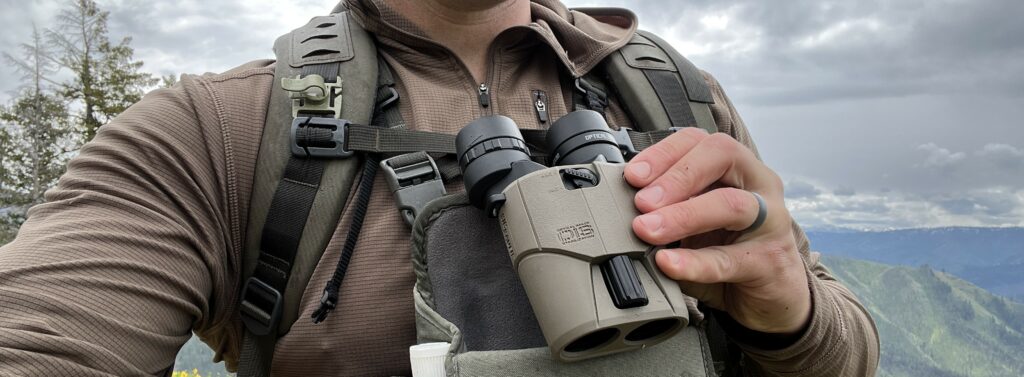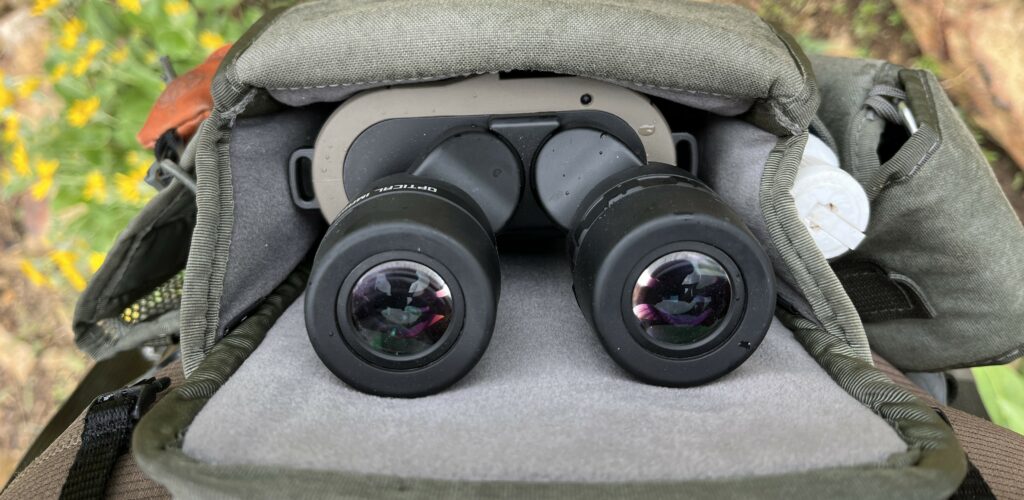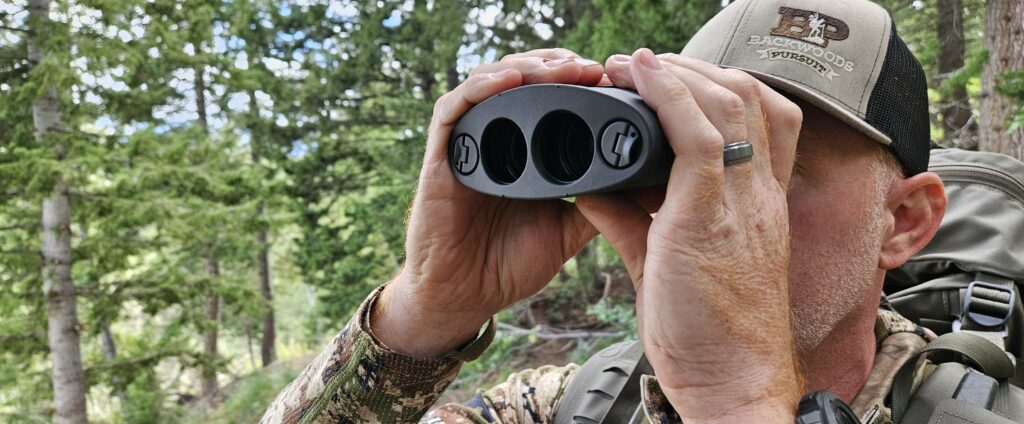Things are changing in the world of optics. Are image stabilized binoculars any good? If so, which ones are the best for hunting? What are the advantages and disadvantages of image stabilized binoculars, and in what situations would you replace your favorite pair of standard binoculars with image stabilized binoculars? We will attempt to sort all of this out in the review to help you decide whether this new wave of image stabilized binoculars is for you or if you will take a pass.
Make sure to check out our other gear reviews and the Backwoods Pursuit YouTube Channel to help you decide what gear will help you stay out in the field longer!
For ages the best way to glass up a big buck or bull was to pull out the tripod, attach you binos, and get to work. With the recent growth in availability and popularity of image stabilized binoculars, the real question is, are image stabilized binoculars better than regular binoculars?
What Are Image Stabilized Binoculars and How Do they Work?
Image stabilization is nothing new in cameras, so it is not a big stretch to see the technology make its way into binoculars, and more specifically, into hunting binoculars. Until recently, they did not exist in the world of hunting, but should they? Image stabilized binoculars work similar to your camera in that the image is cropped to allow the electronics of the stabilization to do their work and float around the image that you are seeing. This results in much slower, less jittery images that often come from shaking hands when glassing offhand.
I am certainly no pro on the technical side of how they work, but one thing has been consistent across all eight pairs of image stabilized binoculars that we have tested: the field of view (FOV) is greatly sacrificed to provide the nice stable image you get.
Pros and Cons of Image Stabilized Binoculars
The real question we want to tackle before diving into our comparison of the Kite APC Image Stabilized Binoculars and the Sig Zulu6 HDX Image Stabilized Binoculars is, are they worth it? What are you giving up to get the image stabilization, under what circumstances would they replace your standard binoculars (if at all), and in what circumstances would you be better off grabbing your favorite binoculars and sticking them on a tripod.
PROS:
IMAGE RESOLUTION
One of the most surprising things we learned from this review was just how good the image resolution is in both these Sig Zulu 6 HDX and the Kite APC stabilized binoculars. We will talk more about their edge to edge clarity below, but the image in the center was outstanding and right in line with most of the other binoculars we have tested in the $1,000 price range. That is pretty impressive given that these have image stabilization built in.
SPOT MORE OFFHAND
This is probably the the single most important benefit you get from image stabilized binoculars. The ability to quickly pull up your binoculars and see animals miles away without retrieving and setting up a bulky tripod is an absolute game changer, to a degree that I believe image stabilized binoculars are the future in the hunting world. They make THAT big of a difference. Imagine having the stability of glassing from a tripod while running and gunning, and that is what it is like to have image stabilized binoculars.
LEAVE THE TRIPOD
A side benefit of taking image stabilized binoculars is that you can save a few pounds by leaving your tripod at home. That is unless you want to have it for a spotting scope or to shoot from, but that is a different discussion. Either way, in some situations like archery elk hunting, I found myself ditching the tripod and just taking the image stabilized binoculars.
EASY DIGISCOPING WITH BINOS
Another benefit our team found while using these image stabilized binoculars is just how fast and easy it was to digiscope (with the right adapter of course). The stabilization allows you to grab some film-worthy clips in a heartbeat and on the fly. If you like to film hunts, or just like to take a lot of pics or videos of your hunts, this is a game changer as well.
SIZE AND WEIGHT
One surprising benefit of picking up these image stabilized binoculars is their relatively small size and light weight. While the Sig Zulu6 were noticeably smaller than the Kite APC, neither were overly bulky and both were very light (see the specs chart for more details).
CONS:
FIELD OF VIEW
The number one downside I have found is that even the best image stabilized binoculars we tested still offer a very small field of view. While this will bother some folks more than others, it is certainly something to consider. For me personally, I found it very limiting in some situations like when I am sitting atop a high ridge picking apart a mountain for deer or elk. The smaller field of view cuts out so much of the image that I likely missed small movements I would have otherwise picked up in the wider FOV provided by the likes of the Swarovski NL Pure or Zeiss SFL I am used to.
EDGE TO EDGE CLARITY
Another downside to image stabilized binoculars is that the edge to edge clarity is a bit lacking. Considering that you already have such a small field of view, this furthers the problem. Now, to be fair, the edge to edge clarity is right in line with most binoculars in their respective price range, so it is not like you are giving up much in that department over a typical $1,000 pair of binoculars. Considering this, the edge to edge clarity is not all that bad, but it is more noticeable due to the smaller field of view to start with.
MOTION SICK FEELING
Many folks have reported a “sea sick” feeling when first using image stabilized binoculars. I will admit, they do take a little getting used to, and that feeling can be amplified if you are scanning quickly. However, I personally got used to them quickly to the point where it did not bother me one bit.
ELECTRONICS INVOLVED
This is honestly one of my biggest concerns in the long term with image stabilized binoculars. Any time electronics are involved, the life span of a product is likely to go down. Just like a rangefinder, companies typically do not warranty electronics as long, and they simply tend to break faster. We will see how this plays out over the years, but it is a real concern for me whereas with typical binoculars, you can buy a quality pair and have them last a lifetime.
ARMS GET TIRED
One last thing that I noticed is that when I am glassing for long periods of time, I found myself wishing my binoculars were on a tripod. Even though the image was nice and stable, my arms would get tired and I would have to let down and rest for a bit. Contrast this with being able to stay in your binoculars for hours at a time when they are on a tripod. That “down time” might just be the moment that buck moves and you were not looking. Sometimes I just felt like I was missing things due to the combination of arm fatigue and the smaller FOV.
One fix for this that Aziak Equipment gives us is a custom designed binocular tripod clamp that fits the Sig Zulu6 HDX. This allows you to put the Sig Zulu6 HDX on a tripod and glass with them just like you would any other pair of binoculars. That solves the issue and makes these image stabilized binoculars ever more versatile.
Sig Zulu6 vs Kite APC Image Stabilized Binoculars
Now that we have gone over the general pros and cons of these image stabilized binoculars, let’s dive into the details of the Sig Zulu6 HDX and the Kite Optics APC that we tested side by side.
AVAILABLE MODELS
Both the Kite Optics APC and the Sig Sauer Zulu6 HDX are offered in a variety of magnifications and configurations. Each one varies and is geared toward a little different use case.
- Kite APC 10×30 Image Stabilized Binoculars
- Sig Zulu6 HDX 10×30 Image Stabilized Binoculars
- Kite APC 12×30 Image Stabilized Binoculars
- Sig Zulu6 HDX 12×42 Image Stabilized Binoculars
- Kite APC 12×42 Image Stabilized Binoculars
- Sig Zulu6 HDX 16×42 Image Stabilized Binoculars
- Kite APC 16×42 Image Stabilized Binoculars
- Sig Zulu6 HDX 20×42 Image Stabilized Binoculars
Specs: Sig Zulu6 vs Kite APC Image Stabilized Binoculars
First let’s take a look at the specs of all the models we tested. We were able to put eight models next to each other for this review, ranging from 10x up to 16x, so we got a pretty good idea of their capabilities.
| Binocular | Weight | FOV @1000yds | Eye Relief | Length | Battery Life | Price |
|---|---|---|---|---|---|---|
| Kite APC 10×30 | 21.7 oz | 289 ft | 17 mm | 6.5 in | 36 hrs (2AA) | $1,058 |
| Sig Zulu6 10×30 | 19.2 oz | 274 ft | 15 mm | 5.9 in | Unspecified | $900 |
| Kite APC 12×30 | 21.7 oz | 274 ft | 17 mm | 6.5 in | 36 hrs (2AA) | $1,078 |
| Kite APC 12×42 | 25.4 oz | 202 ft | 17 mm | 7.2 in | 60 hrs (2AA) | $1,148 |
| Sig Zulu6 12×42 | 21.5 oz | 200 ft | 17 mm | 7.1 in | Unspecified | $1,000 |
| Kite APC 16×42 | 25.9 oz | 205 ft | 14 mm | 7.2 in | 60 hrs (2AA) | $1,213 |
| Sig Zulu6 16×42 | 21.9 oz | 200 ft | 14 mm | 7.1 in | Unspecified | $1,100 |
| Sig Zulu6 20×42 | 21.9 oz | 174 ft | 15mm | 7.1 in | Unspecified | $1,200 |
While the specs are pretty close as a whole, there are a few interesting things to point out here:
- Kite offers a slightly bigger field of view.
- Sig Zulu6 are slightly lighter weight and less bulky.
- Kite 10×30 mm offers more eye relief.
- Kite offers a 12×30 mm model.
- Sig offers a 20×42 mm model.
Optical performance comparison: Sig Zulu6 HDX vs Kite APC
IMAGE RESOLUTION
Image resolution was one of my biggest concerns going into the review of these image stabilized binoculars. Given that you are adding an electronic component in the stabilization, along with the relatively modest price point, I expected to give up a lot in the optical performance department. To my surprise, the image resolution on both the Kite APC and Sig Zulu6 HDX binoculars was quite good. In fact, the resolution at the center of the image was not far off a good pair of similarly priced conventional binoculars. The optical performance of both pairs exceeded my expectations.
If I am really picking the differences apart, I give the slight edge in resolution to the Sig Zulu6 HDX for their minimally better resolution and slightly higher color contrast. It was SUPER close, but ultimately those of us testing thought the Sig Sauer Zulu6 HDX were just a hair better in resolution.
EDGE TO EDGE CLARITY
Edge to edge clarity is not a big deal….that is until you start to notice it. I fully realize that we have been spoiled here at Backwoods Pursuit to test some of the best optics on the planet, so take these comments with that grain of salt.
Edge to edge clarity is one area where the Sig Zulu6 HDX and Kite APC image stabilized binoculars both suffer. Now, that is not terribly surprising for a binocular in the $1,000 price range; however, when combined with the smaller field of view we talked about earlier, the less than stellar edge to edge clarity become a bigger issue. If you know this going into picking up a pair of the Sig Zulu6 HDX or Kite APC binoculars, you are less likely to be disappointed. Both of them were nearly identical in their edge to edge clarity performance, so no real advantage one way or the other in this department.
LOW LIGHT PERFORMANCE
Once again, low light performance was nearly identical between these two across all the models we tested side by side. For reference, we tested the 10x30s next to each other, as well as the 12x42s and 16x42s. The one noticeable performance difference was that the 10×30 configuration gave up a significant amount of low light performance vs the 12×42. We found the 10x30s to lose their ability to resolve an image roughly 10-15 minutes before the 12x42s. This is to be expected with the smaller objective lens of 30 mm vs 42 mm. Otherwise, the low light performance between the two brands was nearly identical.
One small and interesting difference we did notice between the 10×30 models is that the Kite APC seemed to be ever so slightly brighter in low light, while the Sig Sauer Zulu6 HDX seemed to be ever so slightly better in resolution, as noted above.
Stabilization Performance: Sig Zulu6 HDX vs Kite APC
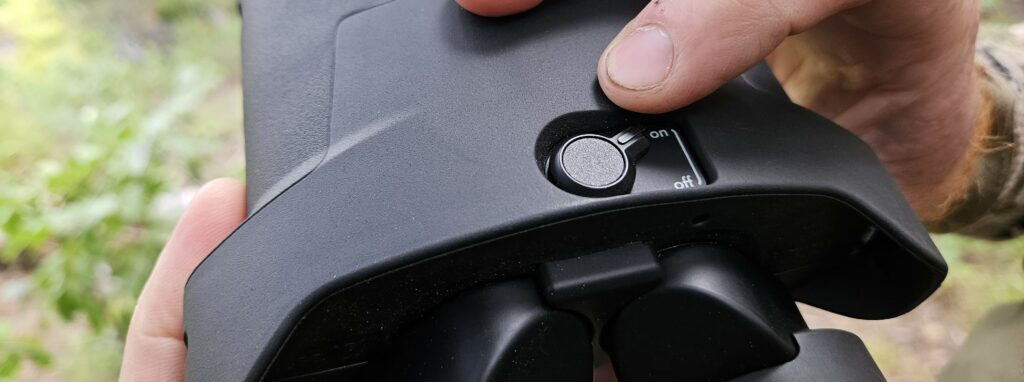
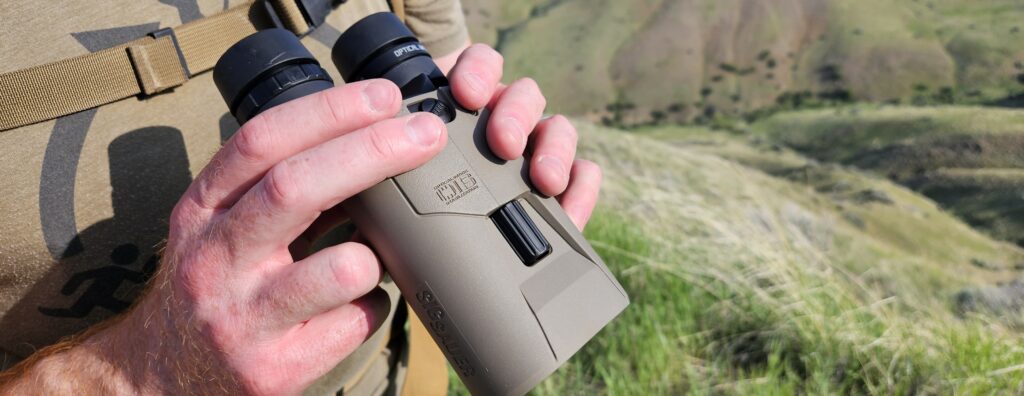
When it comes to image stabilized binoculars, how the stabilization performs is one of the most critical factors. After all, why else would you pick stabilized binoculars? We found there to be a few key differences between the Sig Zulu6 HDX and the Kite APC that we will touch on in the next section. However there were a few performance differences that are also worth noting.
SIG OFFERS ADDITIONAL TARGET MODE
One of those differences is that while the Kite APC offers one stabilization mode, the Sig Zulu6 HDX offers both a standard mode and a “Target Mode”, which further stabilizes the image once you spot something that you want a better look at. We found this target mode to be extremely useful, and dang, it really stabilizes the image. It is a bit of a hassle to activate though as it requires the stabilization to be on, then quickly turn it off and on again. That much movement can easily take you off target.
KITE OFFERS SMOOTHER SCANNING
On the other hand, we found that in the standard mode, we slightly preferred the Kite APC as they seemed to have a small advantage while scanning a hillside. They seemed to be a bit less “herky jerky”, if you will, and offered a little smoother scanning experience. That being said, the Kite also seemed to be more prone to the image falling into a bouncing (side to side) movement that required us to turn the stabilization off, then back on, to reset.
Auto Power Off Function: Sig Zulu6 HDX vs Kite APC
Another of the key differences between the Sig Zulu6 HDX and the Kite APC is their power management functionalities.
AUTO-OFF FUNCTIONALITY DIFFERENCES
The biggest difference between the two was how they operated. More specifically, the Kite APC features their “Auto Power Control” (APC) which puts the unit in sleep mode by simply putting them in the vertical position (like they would be in your bino harness). That feature alone gives the Kite APC a HUGE advantage in this functionality department as I found it to be extremely useful and made them more user friendly in the field. To further this, the Kite Optics APC also has an auto power off that occurs after 90 minutes of being in sleep mode. These layers of battery conservation worked extremely well for us.
Conversely, the Sig Zulu6 HDX features an auto-off after 10 minutes of use. While this also works just fine, it can be frustrating to have the unit turn off after 10 minutes which then requires turning it back on, and we found it to be less user friendly than the Kite APC.
Focus Wheel: Sig Zulu6 HDX vs Kite APC
One of the physical differences between the Kite APC and Sig Zulu6 HDX is their focus mechanisms. Both work adequately, however, there were a couple of differences that we noted.
POSITION / ERGONOMICS


We found the location of the focus wheel to more natural and ergonomic on the Kite Optics APC image stabilized binoculars. Being located right where your hand naturally falls when glassing with the optic just felt better overall than the Sig Zulu6 HDX.
PRECISION
The above being said, we also preferred the functionality of the Sig Zulu6 HDX over the Kite APC as the Sig Zulu6 HDX focus mechanism was more precise and less spongy during use. To be fair, neither were amazingly precise, but the Kite was a bit more difficult to dial in due to the more spongy feel.
Eye Box: Sig Zulu6 HDX vs Kite APC
During our testing we noted that the eye box of the Kite APC seemed to be a bit more forgiving, allowing the user to not have to be quite as precise with how the binoculars were aligned on your face to get a full field of view. There was not a huge difference here but it was noticeable.
Water Resistance: Sig Zulu6 HDX vs Kite APC
Both the Sig Zulu6 HDX image stabilized binoculars and the Kite Optics APC image stabilized binoculars have a waterproof IPX-7 rating so you are protected against the elements you will likely face in the field. So far, after a year of use, we have had zero issues with either of them.
Warranty: Sig Zulu6 HDX vs Kite APC
While warranty is not the biggest determining factor, it is still something to consider. Both the Sig Sauer Zulu6 HDX and Kite Optics APC give you a lifetime warranty on the optic, but Sig Sauer recently included these image stabilized binoculars in their “Infinite Guarantee” lifetime warranty, while the Kite Optics gives you only 2 years on the electronics. Again, the best warranty is one you do not have to use, but the differences between the two are something to consider.
So, Are Image Stabilized Binoculars Worth It?
Circling back to our original question of are they image stabilized binoculars worth it? Do they replace your favorite pair of binoculars? The answer, for me, after using and testing these over the last year is that they absolutely have their place. Depending on what your hunting style or trip is going to look like, they could be a game changer, particularly for those run and gun situations.
However, for me, they do not yet replace a pair of high end binoculars because the optical performance is not on par with them. Yes, the image stabilization makes up for much of the decreased optical performance, but on those hunts when I am sitting and glassing for long periods of time, I will take my Swarovski NL Pure all day long. However, for those trips where I am on the move and do not want to mess with a tripod, both the Sig Zulu6 HDX and the Kite APC are game changers. So, the short answer is yes, they are worth it, depending on what you are doing with them.
Conclusion: Sig Zulu6 HDX vs Kite APC
That is a lot of information on image stabilized binoculars. Hopefully this review will help you narrow down not only if you want to take the plunge into the new world of image stabilized binoculars, but we also hope this arms you with the information you need to pick the right pair for your specific needs and uses. Both the Kite Optics APC and the Sig Zulu6 HDX image stabilized binoculars are game changers, and you cannot go wrong with either of them. That said, take into account the differences between them and go give some image stabilized binoculars a try. I do not think you will be disappointed.
Subscribe to Backwoods Pursuit to get Your FREE Backcountry Gear Worksheet!!!
Dial in your gear list, calculate your pack weight, and lighten up your pack with this handy tool!




